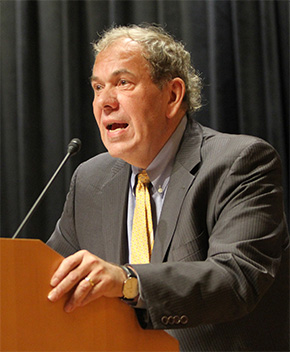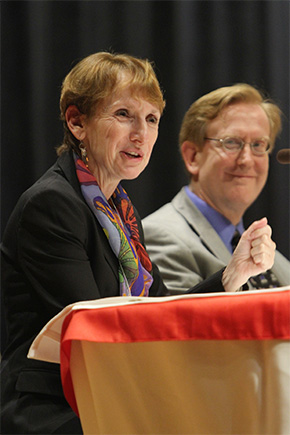Whether the challenges are posed by the Industrial Revolution or today’s digital revolution, the liberal arts have a proven ability to identify and respond to the challenges of the day.
“The liberal arts have never been static,” said Arthur Levine, chairman of the Woodrow Wilson Foundation and chair of the Celebration’s panel on innovation. “The liberal arts, when they’ve been successful, have always had one foot in the academe and one foot in the street.”
 Such nimbleness has always allowed liberal arts education to transform itself to address the needs of a changing society. Just as the colonies needed statesmen and leaders three centuries ago, today’s global economy requires entrepreneurs and visionaries to steward such change.
Such nimbleness has always allowed liberal arts education to transform itself to address the needs of a changing society. Just as the colonies needed statesmen and leaders three centuries ago, today’s global economy requires entrepreneurs and visionaries to steward such change.
“The liberal arts have always been practical,” said Levine. “We’re entering a period like that now. It’s as large of a transformation as we move from a national analog industrial economy to a global digital information economy.”
There are many factors at play – demographics, technology, economics, globalization – but the questions are simple: what’s the purpose of the liberal arts college today and how can we do it better?
Panelists Elizabeth Dinndorf and Donna Heiland offered suggestions to stay relevant, one concrete and the other theoretical.
Dinndorf, president of Columbia (S.C.) College succinctly said, “We have to do more to prepare our students.”
Under her direction, Columbia College created the Institute for Leadership and Professional Excellence, a customized four-year program that aids students in the transition from high school to college and from college to the professional world.
Each Columbia student has a personal board of directors – academic advisor, career counselor, and a community mentor – with the goal of producing graduates who are fully prepared for graduate school, a career, and economic independence.
Further, Columbia College added an advocacy concentration to its political science major and has partnered with three other institutions in creating an applied computing minor.
“We want all of our students have the technical, coding, and applied analytical skills they need, regardless of major, to be successful in a techno-centric world,” Dinndorf said. “Technology is essential.”
Heiland, vice president and special assistant at Emerson College, reimagined higher education as a tool where mastery of academic field was secondary to the formation of the entire person, including ethical action, critical thought, and creative work.
“Engagement is so important,” Heiland said. “The liberal arts really do develop the values, the skills and the knowledge base that allow individuals and societies to thrive.”
Working from the premise that liberal arts education can occur in a myriad of places, Heiland posited an on-line liberal arts commons. Engagement with the liberal arts through an on-line community where anyone could enter and the teaching and learning were fluid.
It’s engagement beyond the classroom walls by using technology as the means to support an active and thriving community.
“What I’ve found is that the engagement can be so intense that if I can think my way past whatever the particular technological issue of the moment is to the actual substantive working conversation that can be done, vital policy conversations can happen, publically oriented humanities work can happen,” said Heilman. “The community is large, is powerful, and is quite diverse.”
The power in those connections is a benefit noted by fellow panelist Dr. Richard Gunderman, Chancellor’s Professor of Radiology, Pediatrics, Medical Education, Philosophy, Liberal Arts, Philanthropy, and Medical Humanities and Health Studies at Indiana University.
“If you open up to people, you realize that there are kindred spirits in your midst,” he said. “As long as we keep ourselves closed up and bottled off, we’re never going to realize those opportunities.”
 Those opportunities point toward a common goal: to strengthen the quality of liberal arts learning for all students. Through the work of Wabash College’s Center of Inquiry in the Liberal Arts, much is known about raising the level of student engagement and teaching quality.
Those opportunities point toward a common goal: to strengthen the quality of liberal arts learning for all students. Through the work of Wabash College’s Center of Inquiry in the Liberal Arts, much is known about raising the level of student engagement and teaching quality.
“We know a great deal about how to do this through the research of the Wabash Center and have many institutions across the country devoted to trying to do this and making some progress,” Heiland said. “We have a ways to go, but we now have a path (to follow).”
With differing opinions of where liberal arts education is heading and what that transition might look like, Gunderman implored attendees not to lose sight of the importance of connections with students, no matter the venue.
“When I think about the moments when I feel the most alive as a teacher, it’s almost invariably these moments when my students feel like they are coming to life in my presence,” Gunderman said. “Ultimately, what makes my work as a teacher most fulfilling is the opportunity to talk with my students; to have genuine conversations. Frequently, that takes place not so much in the classroom, but over coffee, or lunch, or seated on a bench on campus. Like those conversations that open eyes and transform lives, that’s ultimately what we need to keep our gaze fixed on.”
In a day and age where costs are rising and technology has proven to be cost effective in delivering education to the masses, what advantage do campuses have?
As changes come, the answer might be as Gunderman speculated: intimacy.
“We will have three kinds of higher education in the years to come – brick campuses, click campuses (the internet), and combinations thereof,” said Levine. “What liberal arts colleges have to trade on is brick. It’s that intimacy that is going to draw.”
Imagine an in-tune, plugged-in, and intimate campus experience.
“We’re still going to see young people who want the residential experience, whose parents want them to have it, and want them to have a rigorous education with all the characteristics in terms of liberal arts,” Levine continued. “The job of campuses is to make that appealing to them. The job of campuses is to make sure the programs they offer are vibrant, that they fit with these times, and that they are truly as brick-y as they can be.”
The results of the Wabash National Study show that liberal arts learning isn’t limited to a particular setting or campus. Heilman’s charge moving forward is to allow such learning to occur untethered to traditions.
“Do it not as one college, but do it in concert with five other colleges, and banks, and insurance companies, and not for profits and break down the silos, and not constrain the liberal arts within liberal arts institutions,” she said.